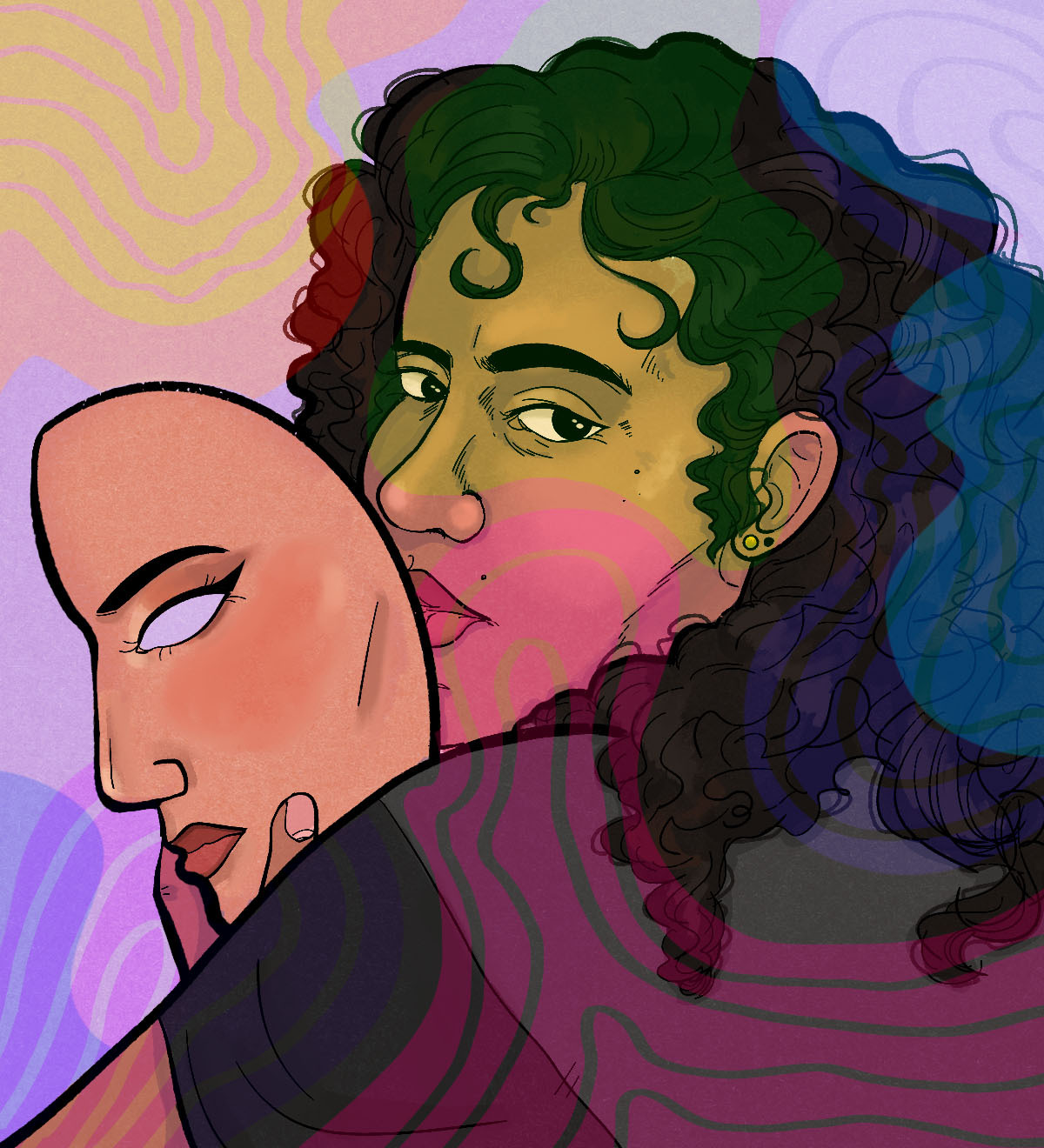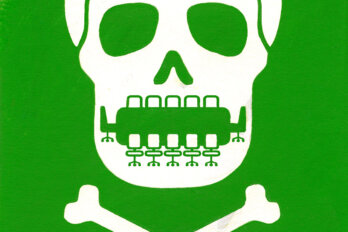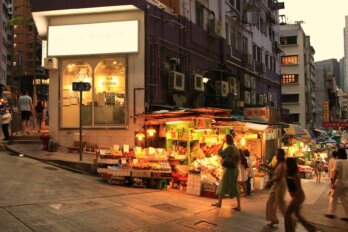I’ve always thought of myself as smart, not pretty. For much of my childhood and adolescence, friends, family, and even strangers would make intrusive comments about my appearance, offering unhelpful advice on how to decrease the width of my hip bones, fix my textured face, or smooth out my thick, curly hair. As a self-proclaimed nerdy feminist who grew up in the “girl boss” era, I would always promptly respond, “I want to be successful, not beautiful.”
It wasn’t until I was older that I realized the two often go together.
One afternoon, after a visit to the mall with my parents when I was sixteen, the three of us sat down at a nearby Moxies- or Earls-type restaurant. The teenage waitress was dressed in a typical uniform: a tight black skirt and fitted long-sleeve shirt. After she took my family’s order, my dad quipped to my mom, “Look at the way that waitress looks.” My mom agreed. “That’s what men like, right, Ashley?” Brimming with anxiety, I looked up at my dad, my face contorted. “That’s what you should look like so you could work here,” he said matter-of-factly.
Many of us are well aware that the workforce doesn’t treat women—especially women of colour—fairly. In Canada, a 2017 study found the gender pay gap to be 11 percent, and women are also far less likely to be promoted or to hold leadership positions. But this was the first time it was made clear to me that beauty is an additional barrier. Looking the part can be a determinant of who gets a job and who doesn’t, who succeeds and who fails, or even whose labour we value most.
In an article for The Cut, titled “Yes, Beautiful People Have a Totally Different Experience of Life,” writer Drake Baer discusses the beauty premium in the labour market, where workers who are more attractive have a higher level of confidence, which leads to higher wages. One study from Iza World of Labor found that attractive workers earn around 10 to 15 percent more than average-looking ones. That’s in addition to those workers being more likely to get the job in the first place and to receive better evaluations.
However, this beauty premium also reveals a more sinister side of work. The entertainment industry has perfected the concept of objectifying women for financial gain. But other industries, especially restaurant and retail, are equally guilty of the same exploitation. And in a world where the pressure of presentation feels unavoidable, many workers feel the need to take on the additional burden of aesthetic labour—that is, the time and cost put into looking, sounding, and even acting the part—in order to succeed.
We all have a mental image of what each profession looks like, whether it’s the white coat–wearing doctor or the lawyer in a power suit. And whether consciously or not, odds are you’ve performed some form of aesthetic labour over the course of your professional life.
According to Joya Misra, a provost professor of sociology and public policy at the University of Massachusetts Amherst who studies social inequality, different beauty expectations based on class, age, gender, and race exist for workers. Certain professions can have more intense restrictions than others, she adds.
At many establishments, servers are expected to be well groomed, without any visible tattoos, facial piercings, or extreme hair or cosmetic styles, though some have dress codes that have become more flexible in recent years. The specific uniform varies, but most require form-fitting pants, skirts, and shirts. Then there are the “breastaurants,” like Hooters, where low-cut tank tops and skimpy bottoms have historically been required. (In 2021, Hooters introduced a new uniform—causing much controversy—that included shorts more closely resembling underwear, though the policy was later rolled back.) In Japan, most women are required to wear high heels in the workplace. Female politicians and businesswomen are often heavily criticized for their outfits in a way that their male counterparts aren’t. In many cases, those who don’t abide by these arbitrary standards risk repercussions, including losing their jobs. In 2011, a Winnipeg waitress was fired for shaving her head. A few years earlier, the same thing had happened to a Las Vegas bartender who refused to wear makeup—a decision that was upheld in court.
Christin El-Kholy knows about these pressures better than most. Now thirty-two years old and a full-time graduate student, she started working in the service industry at the age of sixteen. Coming from a family of Egyptian immigrants who got their start in Canada as dishwashers, El-Kholy was used to getting her hands dirty and being bare faced at work. But, she tells me, she had to invest more in her appearance in order to survive once she started working in customer-facing jobs.
While working at Le Château, her first retail job, when she was sixteen, El-Kholy says, she was expected to wear dresses. “I was always pretty simple. . . . I had, like, a very basic way of getting ready,” she recalls. “After starting, [my bosses] would tell me, ‘Oh, you have to dress a little more girly.’” Later, while working at Moxies and Joey’s, she was shocked to see how many regulations existed, from how high her heels had to be to how her naturally curly hair had to be styled. It took her about an hour each day to straighten her hair and apply makeup and then another hour to commute from Scarborough to Toronto for work. In a 2012 study by YouGov America, 38 percent of women who responded, compared to 21 percent of men, said that they spend more than thirty minutes getting ready in the morning.
In addition to the time investment and psychological stress that goes into presenting oneself a certain way in the workplace, there’s also an undeniable financial component. A 2017 survey by SkinStore found that the average American woman uses sixteen products each day. That works out to about $9 a day for a woman who works in Delaware and $11 per day for one who works in New York. Over the course of her lifetime, the survey estimated, the average New York woman will spend about $300,000 on makeup.
I myself have working-class, racialized friends who have spent hundreds of dollars on beauty procedures while living paycheque to paycheque. One of my cousins even used her hard-earned money to buy a new purse instead of a textbook for a university class she needed to graduate. I remember her squealing about the bag, telling me she looked like the “ladies who work in offices.” I’m not shaming them, because I’ve been there too. When I was younger, I wanted to be a chemist and create a makeup brand for darker skin tones. In my mind, I took the saying “Dress for the job you want, not the job you have” literally. I gleaned what a scientist should look like from television—think Gwen Stacy from Spider-Man—and wanted to look like that too. In my third year of university, I tried to pay—with my student loans—for a nose job and a laser skin resurfacing procedure, which the doctor refused to do. A good five years of my youth were spent starving myself, micromanaging my facial expressions, and monitoring my high-pitched voice to fit my idea of a scientist and, later, a journalist.
Some have been quick to criticize other women for striving to uphold these beauty standards in the first place, saying that they should simply reject them altogether. On an episode of the NPR podcast Code Switch, Noliwe Rooks, an associate professor at Cornell University, argued that people should instead attempt to decolonize Western beauty standards. However, it’s often much more complicated. Pushing back against employment standards is a privilege, since not everyone can afford to jeopardize their employment—especially at a time when, according to the Canadian Centre for Policy Alternatives, over “28 percent of Indigenous Peoples and 31 percent of racialized individuals live with economic insecurity, compared to 16 percent of white individuals.” Coupled with unfair wages, these factors force racialized folks—who make up about 21 percent of the general workforce but account for 22 percent of retail and 30 percent of hospitality work, according to 2016 census data used in a Future Skills Centre report—to take on the additional burden of having to advocate for themselves when it comes to beauty standards.
According to Misra, many retail companies have a racial beauty hierarchy: white on top; a mix of various racial groups such as Latinx, Middle Eastern, or Asian or multiracial people in the second tier; and then visibly Black people at the bottom. This hierarchy, she adds, dictates who gets the best schedules and raises. As part of her research for her new book, Walking Mannequins: How Race and Gender Inequalities Shape Retail Clothing Work, she interviewed former and present retail workers about their experiences. “As women’s skin tones got darker and darker, they were treated less and less well,” she says.
Just look at Abercrombie & Fitch. In Netflix’s 2022 documentary, White Hot: The Rise & Fall of Abercrombie & Fitch, former employees criticized the retailer’s strict practice of only hiring “hot” people (meaning white, blond, and fit). Former workers discussed how they were rated on their appearance. Those who had higher scores were given more shifts, while employees with lower rankings, many of whom were Asian or Black, were slowly given fewer shifts until they weren’t on the schedule. Despite the successful class action lawsuit that was filed against the company in 2003—which claimed that its “looking the part” policy was discriminatory toward Asian American, African American, and Latino individuals—Abercrombie & Fitch continued to adhere to its unfair standards for employees. In 2015, Samantha Elauf, a Muslim fashion blogger, filed a charge against the company when she was denied a job because she wears a hijab; the US Supreme Court ruled in her favour, and she was awarded $20,000 (US) in damages. It’s not just women who are discriminated against. Last July, the World Sikh Organization reported that discriminatory dress-code policies were forcing Sikh security guards out of their jobs because some companies required their workers to be clean shaven, meaning those with religiously mandated beards would not be eligible for employment.
If employers are going to continue to push for restrictive dress codes, Misra suggests, workers should also be compensated for what it takes to meet those standards. According to Misra, this is a form of wage theft, and employers should be accounting, in their employees’ overall work hours and pay, for the time and resources they spend on meeting such standards. If workers need specific outfits or makeup, employers need to cover the associated costs. If it takes a worker an hour to get ready, they should be able to count that toward their work hours.
And perhaps we’re starting to see some progress. A few years ago, over 7,000 employees filed a class action lawsuit against Cosmopolitan Casino in Las Vegas after the company implemented a policy whereby workers were required to change into their uniforms on site but without pay for that time: the employer negotiated a $10 million settlement with the workers. In Canada, some workplaces have, at the very least, started to relax their dress codes. In Ottawa, a group of hospital workers challenged a policy that banned visible tattoos and piercings and won, while in 2018, the Canadian Union of Public Employees filed a human rights violation charge against Air Canada for its policies on uniforms and makeup.
As I’ve gotten older, I’ve still felt the pressure to become beautiful and stay beautiful, but I’m often reminded of my younger self, sitting in that restaurant, thinking to myself that I’d rather be smart. I hope, one day, we won’t be judged by our appearances so much.






